The Nature of Sound - Complete Toolkit
Objectives
- To describe sound as a longitudinal, mechanical, pressure wave that is produced by a vibrating object.
- To understand the concept of frequency as the number of back-and-forth oscillations of a particle about its resting position and to relate the frequency of sound to the pitch.
- To relate the intensity of a sound wave to the amplitude of vibration of the particles of the medium and to use the deciBel equation to calculate intensity or the deciBel level.
- To know that the speed of sound (like any wave) is dependent upon the properties of the medium, to compare the speed of sound in a solid, liquid, and gas, and to relate the speed of sound to the frequency and wavelength of the sound wave.
Readings from The Physics Classroom Tutorial
- The Physics Classroom Tutorial, Sound Waves and Music Chapter, Lesson 1
- The Physics Classroom Tutorial, Sound Waves and Music Chapter r, Lesson 2
Interactive Simulations
- Simple Wave Simulator
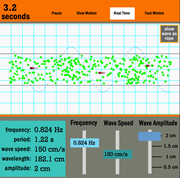 The Simple Wave Simulator from The Physics Classroom provides an excellent introduction to the nature of a mechanical wave. The simulator allows a learner to explore both waves traveling through strings and sound waves traveling through air. The learner may control the frequency, speed, and amplitude of the vibrations. The pattern of crests and troughs are shown for the string wave. For the sound waves, a multitude of air particles are shown vibrating; the formation of rarefactions and compressions is clearly visible. Three particles are color-coded different than the rest, allowing a learner to view the longitudinal motion of the air particles. We highly recommend the accompanying exercise. The exercise guides the learner to key observations and concludes with a short quiz that assesses key understandings.
The Simple Wave Simulator from The Physics Classroom provides an excellent introduction to the nature of a mechanical wave. The simulator allows a learner to explore both waves traveling through strings and sound waves traveling through air. The learner may control the frequency, speed, and amplitude of the vibrations. The pattern of crests and troughs are shown for the string wave. For the sound waves, a multitude of air particles are shown vibrating; the formation of rarefactions and compressions is clearly visible. Three particles are color-coded different than the rest, allowing a learner to view the longitudinal motion of the air particles. We highly recommend the accompanying exercise. The exercise guides the learner to key observations and concludes with a short quiz that assesses key understandings.
- Sound
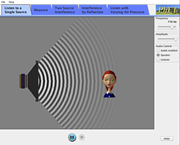 This simulation from PhET has several usage modes. Tapping a tab at the top of the simulation allows one to toggle from one mode to another. Many of the uses are appropriate for the topic of the Nature of Sound. Learners clearly see the compressions and rarefactions produced by a vibrating speaker. The meaning of frequency and amplitude can be clearly visualized as the sliders are used to adjust the value. While the simulation has great value, it is currently available only as a Java Applet and thus not useable on mobile devices, iPads or Chromebooks. We expect that eventually an HTML5 alternative will become available.
This simulation from PhET has several usage modes. Tapping a tab at the top of the simulation allows one to toggle from one mode to another. Many of the uses are appropriate for the topic of the Nature of Sound. Learners clearly see the compressions and rarefactions produced by a vibrating speaker. The meaning of frequency and amplitude can be clearly visualized as the sliders are used to adjust the value. While the simulation has great value, it is currently available only as a Java Applet and thus not useable on mobile devices, iPads or Chromebooks. We expect that eventually an HTML5 alternative will become available.
- Sound Waves
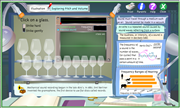 This Flash simulation from the I Know That website provides learners with an appealing interface for exploring the nature of Sound Waves. Basic concepts such as compressions and rarefactions, amplitude and wavelength are discoverable. Interesting background and historical information is provided in short side margin notes. We particularly like the interactive glass tapping simulation. Tap a glass and hear the sound of its vibrations, view the wave form on an oscilloscope, and observe its frequency. Tap a different glass with a different size and observe the difference in frequency and sound. Regrettably, the simulation is a Flash simulation and has limited functionality on modern devices and in modern browsers.
This Flash simulation from the I Know That website provides learners with an appealing interface for exploring the nature of Sound Waves. Basic concepts such as compressions and rarefactions, amplitude and wavelength are discoverable. Interesting background and historical information is provided in short side margin notes. We particularly like the interactive glass tapping simulation. Tap a glass and hear the sound of its vibrations, view the wave form on an oscilloscope, and observe its frequency. Tap a different glass with a different size and observe the difference in frequency and sound. Regrettably, the simulation is a Flash simulation and has limited functionality on modern devices and in modern browsers.
Video and Animations
 Transmission of Sound
Transmission of Sound
This 5-minute video from Designmate discusses the production and transmission of sound waves. Longitudinal waves are discussed and compared to transverse waves. Their transmission at different speeds in different media are discussed and animated. The importance of the particle-to-particle interaction in the transmission through solids, liquids, and gases are explained. Frequency, wavelength, and amplitude are explained.
 What's the Loudest and Faintest Sounds Possible
What's the Loudest and Faintest Sounds Possible
What is the loudest possible sound? What about the quietest thing we can hear? And what do decibels measure, anyway? This video from Joe Hanson and It’s Okay to Be Smart dives into the wide ranging and incredibly sensitive world of sound waves.
 Paint on a Speaker by Slo-Mo Guys
Paint on a Speaker by Slo-Mo Guys
Don't do this experiment at home (nor at school)! Instead, let the Slo-Mo Guys do it for you and enjoy it at high speed without making a mess. The Slo-Mo Guys place lots of colored, latex paint on a speaker and set it into vibration and record the vibrations using a slow motion video camera. The intriguing collection of video clips will make for an eye-catching classroom tool for capturing physics students' attention as you begin a unit of study on the topic of waves and sound.
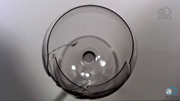 The Coolest Things Sound Waves Do
The Coolest Things Sound Waves Do
This 3-minute YouTube video from DNews begins with a short discussion of what sound is and how it is produced and proceeds to discuss numerous applications of sound. Such applications include the use of sound resonance to break a wine glass, the use of ultrasound in levitation technologies, and the use of sound as a weapon (Long Range Acoustical Device).
Labs and Investigations
- The Physics Classroom, The Laboratory, Listen Up!
Students observe the changes in pitch and loudness of an approaching and receding sound source and draw some conclusions related to the intensity-distance relationship and to the Doppler shift.
- The Physics Classroom, The Laboratory, Mach 1
Students use sound probes and an echo to experimentally determine the speed of sound.
Link: http://www.physicsclassroom.com/lab/sound/Slabs.html
Demonstration Ideas
- Clap to the Beat and Measure the Speed of Sound
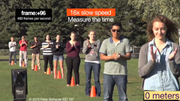 Peter Bohacek is a high school physics teacher who has perfected the art of creating and using Direct Measurement Videos (DMV). A DMV is a video of a physical phenomenon that has been filmed with sufficient attention to detail and scale in order to use the video as a tool for measuring physical quantities. In one of his more recent videos, Peter stages 9 students along a line with each student spaced 10 meters apart. The first student synchronizes her hand-clapping to the sound of a metronome. With eyes closed, each consecutive student synchronizes their hand clap with the sound of the first student's (and thus other students') claps. Because it takes sound some time to travel from the first student to each consecutive student, there is a visible time delay between claps. By shooting the video in slow motion with a high speed camera, the speed of sound can be determined from the distances and the time delays. Enjoy this video and others on Peter's YouTube channel.
Peter Bohacek is a high school physics teacher who has perfected the art of creating and using Direct Measurement Videos (DMV). A DMV is a video of a physical phenomenon that has been filmed with sufficient attention to detail and scale in order to use the video as a tool for measuring physical quantities. In one of his more recent videos, Peter stages 9 students along a line with each student spaced 10 meters apart. The first student synchronizes her hand-clapping to the sound of a metronome. With eyes closed, each consecutive student synchronizes their hand clap with the sound of the first student's (and thus other students') claps. Because it takes sound some time to travel from the first student to each consecutive student, there is a visible time delay between claps. By shooting the video in slow motion with a high speed camera, the speed of sound can be determined from the distances and the time delays. Enjoy this video and others on Peter's YouTube channel.
- The Stadium Wave
 One of the more popular exhibitions of a wave is the so-called "Stadium Wave." Pile several thousand people in a stadium and have some cheerleaders direct the action of "doing the wave." A visible ripple travels from seat to seat as stadium-goers stand up and sit back down in consecutive fashion. This short video is the military version of the Stadium Wave. The demonstration provides a strong visual reinforcement of how a wave can move from one location to another without any movement of matter from the source to the destination.
One of the more popular exhibitions of a wave is the so-called "Stadium Wave." Pile several thousand people in a stadium and have some cheerleaders direct the action of "doing the wave." A visible ripple travels from seat to seat as stadium-goers stand up and sit back down in consecutive fashion. This short video is the military version of the Stadium Wave. The demonstration provides a strong visual reinforcement of how a wave can move from one location to another without any movement of matter from the source to the destination.
- Tuning Fork Vibrations
 There's nothing more fascinating than a video shot with a high-speed camera. Time is slowed down and the invisible and the blurred all of a sudden becomes visible and clear. Such is the case of this video captured in slow motion by the Slo Mo Guys. The video shows the vibrations of the tines of a tuning fork at 1600 frames per second. We recommend that teachers do the demo live in front of their students and then show the slow-motion version as a follow-up.
There's nothing more fascinating than a video shot with a high-speed camera. Time is slowed down and the invisible and the blurred all of a sudden becomes visible and clear. Such is the case of this video captured in slow motion by the Slo Mo Guys. The video shows the vibrations of the tines of a tuning fork at 1600 frames per second. We recommend that teachers do the demo live in front of their students and then show the slow-motion version as a follow-up.
Minds On Physics Internet Modules:
The Minds On Physics Internet Modules are a collection of interactive questioning modules that target a student’s conceptual understanding. Each question is accompanied by detailed help that addresses the various components of the question.
- Sound and Music, Ass’t SM1 - The Nature of a Sound Wave
- Sound and Music, Ass’t SM2 - Characteristics of Sound Waves
- Sound and Music, Ass’t SM3 - Sound Intensity and Decibels
Concept Building Exercises:
- The Curriculum Corner, ChapterGoesHere, The Nature of Sound Waves
- The Curriculum Corner, Sound Waves, Properties of Sound Waves
- The Curriculum Corner, Sound Waves, The Speed of Sound
- The Curriculum Corner, Sound Waves, Sound Intensity and the Decibel System
Problem-Solving Exercises:
- The Calculator Pad, Sound and Music, Problems #1-11
Link: http://www.physicsclassroom.com/calcpad/sound
Science Reasoning Activities:
- Intensity and the Decibel System
- Sound Loudness and the Sone Scale
Link: http://www.physicsclassroom.com/reasoning/sound
Real Life Connections:
- Glass Harmonica
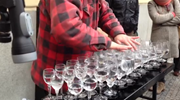 From The Kids Should See This website, Leonard Cohen plays Hallelujah on the glass harmonica. The short video demonstrates several sound concepts such as: vibrating objects produce sound waves; the frequency of the vibrations is dependent upon the properties of the vibrating object; and the frequency affects the pitch that the observer hears. Be sure to follow up the video with a live demonstration in which you make a "wine glass sing."
From The Kids Should See This website, Leonard Cohen plays Hallelujah on the glass harmonica. The short video demonstrates several sound concepts such as: vibrating objects produce sound waves; the frequency of the vibrations is dependent upon the properties of the vibrating object; and the frequency affects the pitch that the observer hears. Be sure to follow up the video with a live demonstration in which you make a "wine glass sing."
- How Loud is Too Loud?
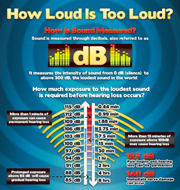 Did you know that prolonged exposure to loud sounds can lead to hearing loss? Scientists have a rather thorough understanding of the association between exposure to loud sounds and hearing loss. This infographic from the Visual.ly website will excite students about the topic of sound waves and deciBels. It is filled with interesting factual information - loudest concerts in the world, loudest sounds in the world, signs of hearing loss, and safety issues associated with exposure to loud sounds.
Did you know that prolonged exposure to loud sounds can lead to hearing loss? Scientists have a rather thorough understanding of the association between exposure to loud sounds and hearing loss. This infographic from the Visual.ly website will excite students about the topic of sound waves and deciBels. It is filled with interesting factual information - loudest concerts in the world, loudest sounds in the world, signs of hearing loss, and safety issues associated with exposure to loud sounds.
- The Visual Microphone: Passive Recovery of Sound from Video
 Researchers at MIT are developing an amazing technology in which they utilize high speed video of an object to "recover" sound. Sound waves impinging upon the object cause it to vibrate; high speed cameras can capture the vibrations of that object. The MIT researchers have developed computer algorithms that translate visual vibrations of the objects into actual sound waves. This YouTube video describes the methodology that makes this possible.
Researchers at MIT are developing an amazing technology in which they utilize high speed video of an object to "recover" sound. Sound waves impinging upon the object cause it to vibrate; high speed cameras can capture the vibrations of that object. The MIT researchers have developed computer algorithms that translate visual vibrations of the objects into actual sound waves. This YouTube video describes the methodology that makes this possible.
Common Misconception:
- Sound Waves Require the Movement of Matter from One Location to Another
This is perhaps one of the most prevalent misconceptions when it comes to waves. It is the (mis-)belief that particles of the medium move from the source to the observer. The misconception is strong in most students' minds prior to instruction and must be directly confronted and replaced with an alternative and more reasonable conception. Our Simple Wave Simulator will go a long distance towards helping students understand the alternative conception. Watching a particle vibrate about a fixed position will help students to realize the possibility of such an alternative conception. Make efforts to convince students that particles of the medium interact with one another such that a repeated vibration of a particle at the source of the wave will result in a time-delayed vibration of a particle much further along the medium. Using a more visible wave such as a Slinky wave will help to illustrate the idea as well. Placing masking tape on one of the Slinky coils and vibrating the Slinky longitudinally will illustrate the proper conception. Finally, persuade students that if particles of the medium did move from the source to the observer, then there would eventually not be any material remaining at the source.
Elsewhere on the Web:
- A Room Built for Total Silence
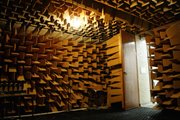 Most of use physics teachers teach a unit on Waves and Sound. In it we teach about vibrations being the source of sound and sound waves propagating outward from the vibrating object to the observer to creates some form of auditory response. But perhaps more interesting than the topic of sound would be the topic of silence. Imagine what it would be like in a room that was created to absorb all the sounds created by vibrating things. Such a room is called an anechoic chamber. In today's post, we're including a link to a relatively short article on what it is like inside a room that has been built for total silence.
Most of use physics teachers teach a unit on Waves and Sound. In it we teach about vibrations being the source of sound and sound waves propagating outward from the vibrating object to the observer to creates some form of auditory response. But perhaps more interesting than the topic of sound would be the topic of silence. Imagine what it would be like in a room that was created to absorb all the sounds created by vibrating things. Such a room is called an anechoic chamber. In today's post, we're including a link to a relatively short article on what it is like inside a room that has been built for total silence.
- The Loudest Speaker in the World
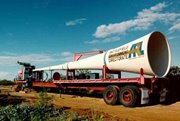 Sometimes turning an amp up to eleven simply doesn’t cut it. If you’re looking for something to point back at those cars that drive by your house with the bass cranked, this speaker (which is likely the loudest speaker in the world) might just do the trick for you. The “Was 3000”, made by Wyle Laboratories can produce a sound level of 165 dB, which can literally melt the wax out of your ears. Students will likely find this to be a fascinating application of sound intensity and deciBels.
Sometimes turning an amp up to eleven simply doesn’t cut it. If you’re looking for something to point back at those cars that drive by your house with the bass cranked, this speaker (which is likely the loudest speaker in the world) might just do the trick for you. The “Was 3000”, made by Wyle Laboratories can produce a sound level of 165 dB, which can literally melt the wax out of your ears. Students will likely find this to be a fascinating application of sound intensity and deciBels.
Standards:
A. Next Generation Science Standards (NGSS)
Disciplinary Core Ideas
- HS-PS4-1 Wave Properties:
The wavelength and frequency of a wave are related to one another by the speed of travel of the wave, which depends on the type of wave and the medium through which it is passing.
Crosscutting Concepts
Patterns
- Mathematical representations are needed to identify some patterns.
Energy
- Energy cannot be created or destroyed—it only moves between one place and another place, between objects and/or fields, or between systems.
Science and Engineering Practices
Practice #2: Developing and Using Models
- Develop and/or use a model (including mathematical and computational) to generate data to support explanations, predict phenomena, analyze systems, and/or solve problems.
Practice #3: Planning and Carrying Out Investigations
- Make directional hypotheses that specify what happens to a dependent variable when an independent variable is manipulated.
Practice #4: Analyzing and Interpreting Data
- Analyze data using tools, technologies, and/or models (e.g., computational, mathematical) in order to make valid and reliable scientific claims or determine an optimal design solution.
Practice #5: Using Mathematics and Computational Thinking
- Apply techniques of algebra and functions to represent and solve scientific and engineering problems.
Practice #6: Constructing Explanations
- Construct and revise an explanation based on valid and reliable evidence obtained from a variety of sources (including students’ own investigations, models, theories, simulations) and the assumption that theories and laws that describe the natural world operate today as they did in the past and will continue to do so in the future.